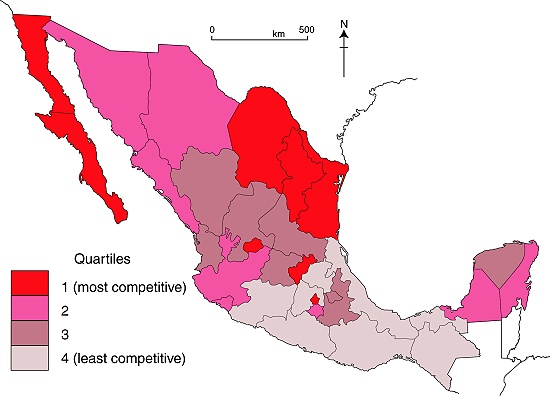A recent report from the Mexican Institute for Competitiveness (Instituto Mexicano para la Competitividad, IMCO) provides some interesting insights into which areas of Mexico are “most competitive” in business terms. The latest report relies on 2008 data. The IMCO Competitiveness figures are usually compiled for a major urban area or a state, and international comparisons are also possible at the country level. For example, IMCO found that Mexico ranks 31st in the world for competitiveness, immediately behind Brazil, but ahead of China (rank 38). Mexico’s basic pattern of competitiveness at the state level is shown in the map.
IMCO defines competitiveness as the capacity to attract and retain investment and talent. This suggests a business environment that maximizes the socio-economic potential of both the business entities and individuals residing in a a specific area. It also suggests that any improved well-being (economic and social) will be maintained (sustained).
The IMCO index of competitiveness is based on 120 key variables, grouped into 10 major factors affecting competitiveness. All the variables must be ones which are regularly updated and easy to interpret, with transparent methods of calculation. The 10 major factors include the reliability and objectivity of the legal system, the sustainable management of the natural environment, the stability of macroeconomic policies, the degree to which society is non-divisive, educated and healthy, and the stability and functioning of the political system.
- Using the map above, how would you describe the pattern of competitiveness in Mexico? (north/south? coastal/inland?, proximity to the USA?)
- Does the pattern of competitiveness match the pattern of GDP/capita? In what way is the State of Mexico an anomaly in this regard? Are there other anomalies?
A full analysis of why some states are more competitive than others is beyond the scope of this post. However, given its relevance to geographers, we will examine the specific variables that make up the sustainable management of the natural environment in a future post, when we will also take a look at the trends for that indicator.
- Full IMCO report on the Competitiveness of Mexico’s states (large pdf file)
- Summary of IMCO report on the Competitiveness of Mexico’s states (pdf file)
Mexico’s economy and workforce are analyzed in chapters 14 to 20 of Geo-Mexico: the geography and dynamics of modern Mexico. Ask your library to buy a copy of this handy reference guide to all aspects of Mexico’s geography today! Better yet, order your own copy…

Sorry, the comment form is closed at this time.